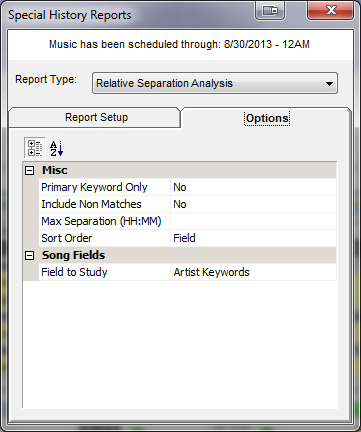MusicMaster Blog
The Relative Separation Analysis Special History Report posted on March 3rd, 2014
By Drew Bennett
Scroll through Special History Reports and you will see one you can use for just about any report you need to generate. Most of these reports are specially designed for certain agencies and offices to receive reports on music you play. Some of these reports, however, are more generic and these are designed for anyone to use. If you haven’t reviewed the Special History Report option lately, we’ve added to the gallery of report options in MusicMaster. The newest report is Relative Separation Analysis. This report determines separation times on values in a field across to adjacent time periods and is a great way to track things like Song Titles and Artist Keywords and how they separate from day to day.
Head to Dataset, Analysis, Special History Reports. In the pop screen, use the dropdown menu and choose Relative Separation Analysis from the list of reports.
Now, choose the Options tab and let’s take a look at what you can do with the report. The first option, Primary Keyword Only, allows you to specify whether or not to limit this report to the Primary Keyword of the keyword field you use. For example, if the field to study is Artist Keyword, you can either choose to only see relative separation from Primary Keywords only or all keywords.
Including Non Matches reports on all keywords whether they have a matching keyword to the adjacent day or not.
Max Separation gives you the ability to set a maximum separation time on which to reports. Any time above your specified time will be eliminated from the report.
Sort Order allows you to sort the report by various methods: Field, Separation or Play Time.
Finally, you’ll want to set the Field to Study. In the example screenshot below, we’ve chosen Artist Keyword but you may choose other fields like Title, Title Keywords, etc.
 When you run the report, you will see several columns of information: Period Play, Against Play, Separation and the Field of Study.
When you run the report, you will see several columns of information: Period Play, Against Play, Separation and the Field of Study.
Period Play shows the play of the Field of Study that is being tested. Against Play shows the play on the adjacent day. Separation shows the relative separation time of the two plays tested. The Field of Study shows the value in that field that is being tested.
It’s a great way to get a bird’s eye view of how certain fields place and separate throughout your hours day-to-day. You might use this on Title Keywords to determine how like titles place and separate day-to-day. This report might best be used on Artist Keywords to determine how close artists play every day. For instance, you may notice an artist plays at 6:05pm on one day and 6:15pm the next. Your relative separation time would be around 10 minutes.
The Relative Separation Analysis report is a great new way to check on your database with just a couple of clicks. Now, you can perform a quick analysis of the separation time of songs with the same value in a given field across two adjacent time periods.
If you have any questions about this report or any Special History Report, call your assigned Music Scheduling Consultant here at MusicMaster. Happy Scheduling!

